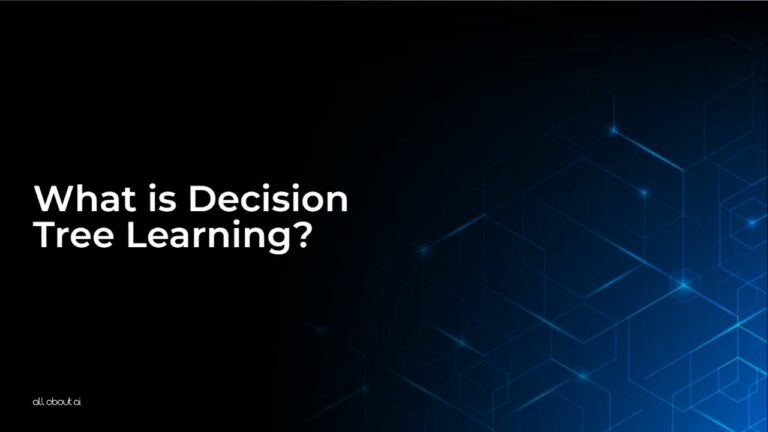Decision Tree Learning stands at the forefront of Artificial Intelligence and Machine Learning, offering a versatile approach to predictive modeling. This method involves breaking down data into smaller subsets while simultaneously developing an associated decision tree. The final outcome is a tree-like model of decisions crucial for various applications in tech industries.
In this article, we will entail “What is Decision Tree Learning?” in detail, along with types, applications, and everything in between. So what are you waiting for? Keep reading the article written by Machine Learning Experts at All About AI.
Imagine you’re playing a game of “20 Questions,” where you try to guess what your friend is thinking by asking yes or no questions. Each question you ask helps you get closer to the answer. Decision Tree Learning is a bit like playing this game, but instead of guessing what your friend is thinking, it helps computers make smart choices based on the information they have. In Decision Tree Learning, we start with a big bunch of information (data) and start asking questions to split this big bunch into smaller groups. Each time we ask a question, it’s like taking a step down a path in a tree, where each branch represents a yes or no answer. We keep doing this until we have a lot of little paths that lead us to answers. This “tree” of questions and paths helps computers predict what to do in different situations, like helping your phone understand what you’re saying or recommending a new game you might like to play. This way of teaching computers is very important in the world of Artificial Intelligence (AI) and Machine Learning, which is all about making computers smarter and able to do things on their own. It’s used in lots of cool tech stuff, from helping cars drive themselves to making your favorite apps even better.What is Decision Tree Learning? The Roots and Branches
Decision Tree Learning – An Overview
Now that you briefly understand the concept of “What is Decision Tree Learning?” Let’s take an immediate overview of it. It is a powerful method in machine learning, known for its simplicity, interpretability, and wide applicability in various domains.
Algorithm Type:
Decision trees are non-parametric, supervised learning algorithms used for both classification and regression tasks.
Structure:
They consist of a tree-like model of decisions, with each internal node representing a test on an attribute, branches representing the outcome of the test, and each leaf node representing a class label.
Learning Process:
The algorithm selects the best attribute for data splitting at each node based on statistical measures, recursively building the tree from a training dataset.
Handling of Data:
Capable of handling both numerical and categorical data, decision trees can also manage missing values and outliers effectively.
Advantages and Limitations:
While decision trees are easy to understand and interpret, they can be prone to overfitting. Techniques like pruning are used to enhance their generalization capabilities.
Fundamental Concepts of Decision Trees:
A Decision Tree, central to understanding “What is Decision Tree Learning”, is a flowchart-like structure where each internal node represents a test on an attribute, each branch represents the outcome of the test, and each leaf node represents a class label.
Basic Structure of a Decision Tree
A Decision Tree is a graphical representation of possible solutions to a decision based on certain conditions. It’s structured hierarchically, showcasing a series of choices and their possible outcomes, including chances of occurrence.
Root Node
The root node signifies the entire dataset being analyzed. It’s the starting point of the decision tree. From here, the data is divided into subsets based on an attribute chosen by the algorithm. This node doesn’t have a parent node and branches out based on the most significant attribute.
Leaf Nodes
Leaf nodes represent the final outcomes or decisions. They are the terminal nodes that don’t split further. Each leaf node is an answer to the series of questions starting from the root and signifies the decision reached after computing all attributes.
Splitting
Splitting is the process of dividing a node into two or more sub-nodes. It occurs at the root node and internal nodes where the data is split into homogeneous sets. This process is crucial for decision trees as it determines the accuracy and efficiency of the decision-making process.

Pruning
Pruning involves the removal of parts of the tree that are unnecessary or less powerful in classifying instances. It reduces the complexity of the final model, thereby enhancing its predictive power and preventing overfitting.
Branch / Sub-Tree
A branch or sub-tree represents a subsection of the entire decision tree. Each branch corresponds to a possible outcome and leads to further nodes, which could either be more decision points (internal nodes) or final outcomes (leaf nodes).
Advanced Concepts in Decision Tree Learning
Now, let’s learn about some advanced terminologies related to Decision Tree Learning.
Entropy
Entropy in decision trees measures the level of uncertainty or disorder in the dataset and is crucial in the attribute selection phase. Originating from information theory, it quantifies the unpredictability of information content.
Entropy is calculated based on the frequency of each category in the dataset and used to build efficient tree by choosing the attribute that minimizes entropy, leading to the most structured and least chaotic split.
Information Gain
Information Gain signifies the reduction in entropy after splitting the dataset on a specific attribute. It’s a key metric that quantifies how effectively an attribute separates training examples according to their target classification.
The attribute with the highest information gain is selected for splitting, as it leads to a more accurate decision tree. This measure is calculated by evaluating the difference in entropy before and after the split.
Tree Pruning
Tree Pruning is a critical technique in decision tree learning aimed at reducing overfitting and enhancing the model’s ability to generalize. It involves simplifying the tree by removing branches that have little power to classify instances.
This process involves a trade-off between the depth of the tree and the model’s performance, and includes methods like pre-pruning, which halts tree construction early, and post-pruning, which removes branches from a fully grown tree.
Hyperparameter Tuning
Hyperparameter Tuning is a critical step in enhancing the performance of Decision Tree algorithms in machine learning. This process involves adjusting various parameters that govern the tree’s construction and behavior.
How Decision Trees Work?
This section breaks down the mechanics of decision trees, a pivotal aspect of AI, illustrating their role in data sorting, pattern recognition, and informed decision-making in complex systems.
Building a Decision Tree
The construction of a Decision Tree is a methodical process that involves organizing data in a way that models decision-making paths. This process can be broken down into several key steps:

Data Splitting
The first step in building a Decision Tree is dividing the available data into two sets: the training set and the testing set. This is crucial for the model’s validity, as the training set is used to build the tree, and the testing set is used to evaluate its performance and accuracy.
Choosing the Best Attribute
Once the data is split, the next step is to determine the best attribute or feature to split the data at each node. This is done using measures like Gini Impurity or Entropy. These measures help identify the attribute that best separates the data into homogeneous groups that are as distinct as possible.
Tree Construction
Starting from the root node, the dataset is split based on the selected attribute. This process forms the basis of the tree structure, where each split represents a decision rule and leads to further branches.
Recursive Splitting
The process of splitting continues recursively, where each subset of the dataset is further split at each internal node. This process continues until all data points are classified, or other predefined stopping criteria, such as a maximum tree depth, are met.
Pruning
Finally, to prevent overfitting and ensure the model’s generalizability, pruning is applied to the tree. This involves removing sections of the tree that provide little to no power in classifying instances, thus simplifying the model and improving its predictive ability.
Attribute Selection Measures
The choice of attribute at each step in a Decision Tree is guided by attribute selection measures. These measures are critical as they directly influence the effectiveness and complexity of the tree.
Common measures include Entropy, Information Gain, and the Gini Index. The chosen measure determines how the dataset is split at each node, impacting the overall structure and depth of the tree.
Decision-Making in Decision Trees
In practice, Decision Trees simulate a decision-making process. Starting from the root node, each branch of the tree represents a possible outcome or decision based on specific conditions. This process continues until a leaf node is reached, which provides the final decision or classification.
Decision Trees are used in various real-life scenarios, such as credit scoring and medical diagnosis. Their rule-based nature makes them one of the most interpretable and straightforward machine learning models.
Strengths and Weaknesses
Understanding the strengths and weaknesses of Decision Trees is crucial for their effective application in real-world scenarios.
Strengths:
- Simplicity and Interpretability: Their straightforward structure makes them easy to understand and interpret, even for those with limited technical expertise.
- Versatility: Decision Trees handle both numerical and categorical data and can be used for various applications across different domains.
- Non-Parametric Nature: They don’t require much data pre-processing, can handle missing values, and do not assume a particular distribution of the data.
Weaknesses:
- Overfitting: Decision Trees are prone to overfitting, especially with complex trees, making them less effective on unseen data.
- Less Effective with Unstructured Data: They are less suitable for tasks involving unstructured data like image and text processing.
- Bias Towards Dominant Classes: Decision Trees can be biased towards dominant classes, leading to imbalanced classification in some cases.
Types of Decision Trees
Now that you have understood the basic concept of “What is Decision Tree Learning?” here are some of the most common types of Decision Trees.
ID3 Algorithm
ID3 (Iterative Dichotomiser 3) is one of the earliest algorithms used for constructing Decision Trees. It primarily uses Information Gain as the attribute selection measure, making it efficient in categorical attribute-based splitting.

Due to its simplicity, ID3 is often faster and more suited for smaller datasets. However, its limitation lies in handling only categorical attributes, which restricts its application in datasets with continuous variables.
C4.5 Decision Tree Model
C4.5 is an extension of the ID3 algorithm, known for its improvements and enhancements. It handles both continuous and discrete attributes, and implements tree pruning to reduce overfitting.
This model is widely popular for its robustness and adaptability. C4.5 also has the capability of handling missing data and can convert the decision tree into a set of if-then rules, enhancing its interpretability.
CART Methodology
Classification and Regression Tree (CART) methodology is another popular decision tree algorithm used for both classification and regression tasks.
It differentiates itself by using the Gini Impurity Index as a measure for splitting. CART creates binary trees, which simplifies the decision process. Additionally, it employs cost-complexity pruning, which aids in better model generalization and avoiding overfitting.
Decision Trees in Practice
Decision Trees are fundamental in machine learning, offering versatile applications across various sectors due to their simplicity, interpretability, and customizable nature.
Business Analytics:
Utilized extensively in business for risk assessment, customer segmentation, and strategic planning, aiding in informed decision-making based on data trends.
Healthcare:
Employed in medical diagnostics to analyze patient data for symptom assessment and treatment pathways, enhancing accuracy and efficiency in patient care.
Financial Services:
Applied in finance for credit scoring, fraud detection, and risk management, offering clear, data-based insights for financial decision-making.
Retail and E-commerce:
Used for predicting customer purchasing behavior, optimizing inventory management, and tailoring marketing strategies to consumer trends.
Environmental Science:
Assists in environmental studies and wildlife conservation, analyzing patterns and impacts in ecological data for sustainable decision-making.
Applications of Decision Trees in Classification and Regression Tasks
In this section, we will delve into the versatility of decision trees, highlighting their effectiveness in sorting complex datasets into clear categories, and predicting continuous outcomes with precision.
Classification:
Decision Trees excel in classifying data into predefined categories, making them perfect for tasks like email filtering and customer segmentation.
Regression:
They are adept at predicting continuous values, such as pricing or temperature, demonstrating their versatility in various predictive modeling scenarios.
Versatility and Efficiency:
Their adaptability to different data types and efficiency in processing large datasets underscore their utility in a wide range of applications.
Dive into the domain of artificial intelligence using our expertly selected glossaries. Whether you’re a novice or an experienced learner, there’s always something fresh to discover!Want to Read More? Explore These AI Glossaries!
FAQ’s
Here are some of the most commonly asked questions about the respective topic other than “What is Decision Tree Learning?”
What is the main idea of the decision tree?
What do you mean by decision tree approach?
When would you use a decision tree?
What is the disadvantage of decision trees?
Conclusion:
Decision Tree Learning is a fundamental technique in machine learning, offering clarity, interpretability, and versatility. While they have their limitations, such as susceptibility to overfitting, their strengths in handling diverse data types and ease of use make them a valuable tool in any data scientist’s arsenal.
In this article, we have comprehensively discussed “What is Decision Tree Learning?” and everything you want to know about it in detail. To understand more AI-related concepts and terminologies like this, do check out more articles in the AI Terminology Guide.





